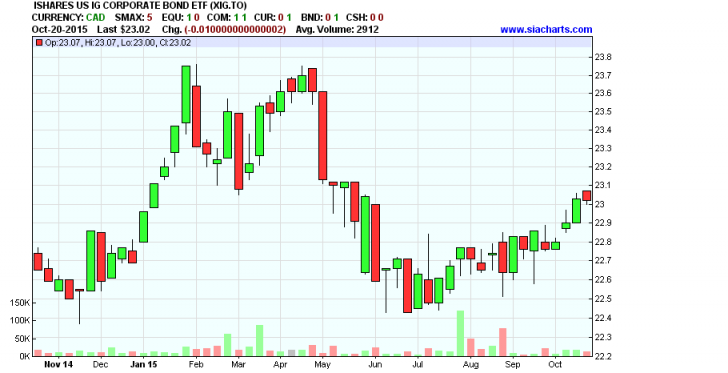SIA Weekly: How are Corporate Bond ETFs, Hedged and Unhedged Doing?
For this week’s SIA Equity Leaders Weekly, we are going to take a look at the SIA Asset Class Rankings (ACR) and specifically at the top ranked asset class, Bonds. Within the broad bond universe we have many choices depending on our needs: Canadian, International , Corporate bonds, Government bonds, Short-Term, Medium, and Longer Duration.
When it comes to investing in the Bond market and looking at the ETF options available to us, we often just look at Fees, Credit Quality, Yield to Maturity, and Duration. With the continual very low interest rate environment in both Canada and the US, our analysis must also focus on the affects of currency. Today we will focus on looking at the BMO Mid-Term U.S. IG Corporate Bond Index ETF (ZIC.TO)* and the very similar iShares U.S. IG Corporate Bond Index ETF (CAD-Hedged) (XIG.TO).
BMO Mid-Term US IG Corporate Bond Index ETF (ZIC.TO)*
The BMO Mid-Term U.S. IG Corporate Bond Index ETF has been designed to replicate, to the extent possible, the performance of the Barclay’s U.S. Investment Grade 5-10 Year Corporate Bond Index, net of expenses. The portfolio consists of United States dollar-denominated, investment grade, fixed rate, taxable corporate bonds between 5-10 years until maturity. This has been a top ranked Canadian traded ETF within the CAD Global Fixed Income report which allows the Canadian investor using Canadian funds exposure to the US Investment Grade bonds. What it also gives the investor is direct exposure whether positive or negative to the movements of the US dollar.
From the chart to the right you can see that over the past one year the price of this ETF has risen over 16%. Now compare this to the very similar but Canadian dollar hedged version.
*Disclosure: ZIC.TO is presently held within certain portfolios managed by SIA Wealth Management Inc.
Click on Image to Enlarge
iShares U.S. IG Corporate Bond Index ETF (CAD-Hedged) (XIG.TO)
The iShares U.S. IG Corporate Bond Index ETF (CAD-Hedged) seeks to provide income by replicating, to the extent possible, the performance of an index which is a widely recognized, diversified and representative index of the USD-denominated investment grade corporate bond market, net of expenses, and, to the extent possible, hedge any resulting U.S. dollar currency exposure to Canadian dollars.
These two portfolio are not exactly the same but are very similar; similar MER, Duration, Yield, Sector Exposure, Credit Ratings, and Maturity Breakdown. Where the difference lies is that in the past one year this ETF has returned 1.19% vs. the above unhedged version of 16.43%.
Currency makes all the difference. Yes bonds are the number one ranked asset class, but which bonds. For those creating their own custom bond relative strength matrixes, similar to most Canadian equities vs. their US counterpart, you'll find that it's the US fixed income that is currently ranking at the top of the list.
Click on Image to Enlarge
SIACharts.com specifically represents that it does not give investment advice or advocate the purchase or sale of any security or investment. None of the information contained in this website or document constitutes an offer to sell or the solicitation of an offer to buy any security or other investment or an offer to provide investment services of any kind. Neither SIACharts.com (FundCharts Inc.) nor its third party content providers shall be liable for any errors, inaccuracies or delays in content, or for any actions taken in reliance thereon.
For a more in-depth analysis on the relative strength of the markets, commodities, currencies or for more information on SIACharts.com, you can contact our customer support at 1-877-668-1332 or siateam@siacharts.com.

















